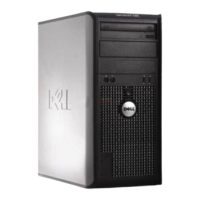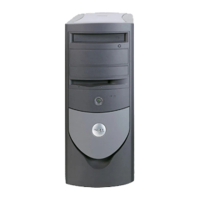Solving Problems 293
Restoring Default Settings
Serial or Parallel Device Problems
Fill out the Diagnostics Checklist as you complete these checks.
CAUTION: Before you begin any of the procedures in this section, follow the safety instructions
located in the Product Information Guide.
NOTE: If you are having a problem with a printer, see "Printer Problems."
CHECK THE PRINTER CABLE CONNECTIONS —
• See the printer documentation for cable connection information.
• Ensure that the printer cables are securely connected to the printer and the computer.
TEST THE ELECTRICAL OUTLET — Ensure that the electrical outlet is working by testing it with another
device, such as a lamp.
VERIFY THAT THE PRINTER IS RECOGNIZED BY WINDOWS —
1
Click the
Start
button, click
Control Panel
, and then click
Printers and Other Hardware
.
2
Click
View installed printers or fax printers
.
If the printer is listed, right-click the printer icon.
3
Click
Properties
and click the
Ports
tab. For a parallel printer, ensure that the
Print to the following
port(s):
setting is
LPT1 (Printer Port)
. For a USB printer, ensure that the
Print to the following port(s):
setting is
USB
.
REINSTALL THE PRINTER DRIVER — See the printer documentation for instructions
TO RESTORE THE COMPUTER'S SYSTEM SETTINGS TO THEIR DEFAULT VALUES —
1
Turn on or restart your computer.
2
When
Press <F2> to Enter Setup
appears in the upper-right corner of the screen, press <F2>
immediately.
If you wait too long and the Microsoft
®
Windows
®
logo appears, continue to wait until you see the
Windows desktop. Then shut down your computer through the
Start
menu and try again.
3 Under System Management, select the Maintenance option and follow the directions on the screen.

